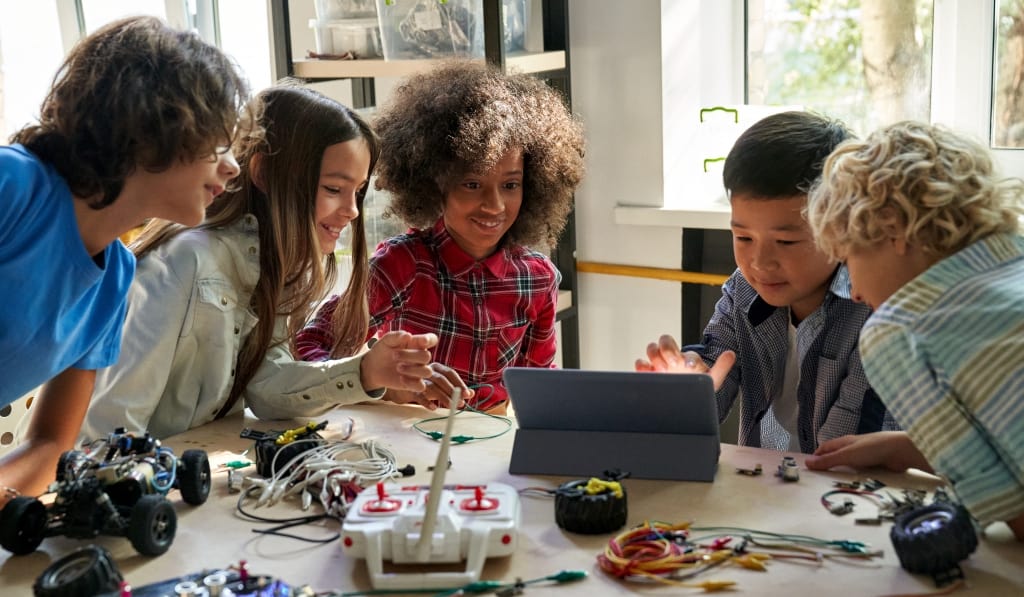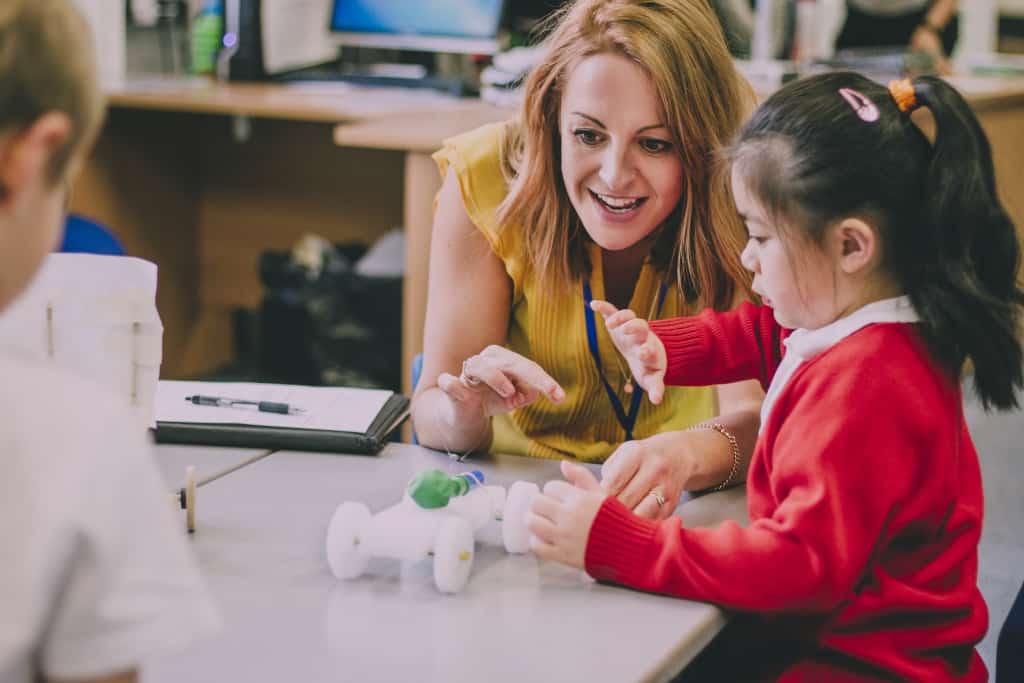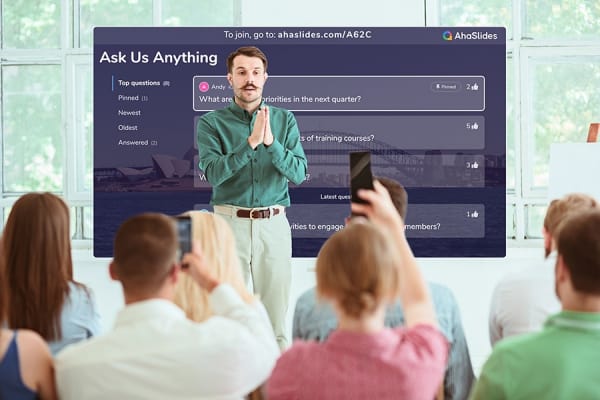एचएमबी क्या है? परियोजना आधारित ज्ञानयही कारण है कि हममें से कई लोग कला, संगीत, नाटक जैसी कक्षाओं को अपने स्कूल के सबसे सुखद वर्षों के रूप में देखते हैं।
यही कारण है कि मेरे स्कूल के काष्ठकला कक्ष, विज्ञान प्रयोगशालाएं और पाककला कक्षा के रसोईघर हमेशा सबसे अधिक आनंदमय, उत्पादक और यादगार स्थान रहे हैं...
बच्चे बस प्यार करते हैं कर बातें।
यदि आपने कभी घर पर अपने बच्चे से दीवार पर बनी “कलाकृतियाँ” या लेगो मलबे के पहाड़ साफ किए हों, तो आप शायद यह पहले से ही जानते होंगे।
गतिविधि एक है महत्वपूर्ण यह बच्चे के विकास का एक हिस्सा है, लेकिन स्कूल में अक्सर इसकी अनदेखी की जाती है। शिक्षक और पाठ्यक्रम ज़्यादातर जानकारी के निष्क्रिय सेवन पर ध्यान केंद्रित करते हैं, या तो सुनने या पढ़ने के माध्यम से।
लेकिन कर is सीख रहा हूँ। वास्तव में, एक अध्ययन में पाया गया कि कक्षा में सक्रिय रूप से काम करने से समग्र ग्रेड में a . की वृद्धि हुई विशाल 10 प्रतिशत अंक, यह साबित करते हुए कि यह छात्रों को सीखने के लिए सबसे प्रभावी तरीकों में से एक है।
निष्कर्ष यह है – उन्हें एक प्रोजेक्ट दें और उन्हें खिलते हुए देखें.
प्रोजेक्ट-आधारित शिक्षण इस प्रकार काम करता है...
अवलोकन
| प्रोजेक्ट-आधारित शिक्षा पहली बार कब पाई गई थी? | 1960s |
| कौन अग्रणी पीपरियोजना आधारित शिक्षण तकनीक? | बैरोज़ और टैम्बलिन |
विषय - सूची
बेहतर जुड़ाव के लिए टिप्स

क्या आप अपने प्रोजेक्ट को बेहतर ढंग से प्रबंधित करने के लिए एक इंटरैक्टिव तरीका खोज रहे हैं?
अपनी अगली मीटिंग के लिए खेलने के लिए निःशुल्क टेम्पलेट और क्विज़ प्राप्त करें। निःशुल्क साइन अप करें और AhaSlides से जो चाहें प्राप्त करें!
🚀 निःशुल्क खाता प्राप्त करें
प्रोजेक्ट-बेस्ड लर्निंग क्या है?
परियोजना-आधारित शिक्षा (पीबीएल) तब होती है जब एक छात्र, छात्रों के कई समूह या पूरी कक्षा एक में संलग्न होती है चुनौतीपूर्ण, रचनात्मक, प्राप्त, समर्थित, लंबे समय तक परियोजना.
ये विशेषण इसलिए और भी अधिक महत्वपूर्ण हो जाते हैं, क्योंकि स्पष्ट रूप से, जब टेक्सटाइल्स की कक्षा में 10 मिनट शेष रह गए हों, तो पाइप क्लीनर से जानवर बनाना पीबीएल के अंतर्गत नहीं गिना जाता।
पीबीएल के लिए अर्हता प्राप्त करने के लिए एक परियोजना के लिए, यह होना चाहिए 5 चीजें:
- चुनौतीपूर्ण: किसी समस्या को हल करने के लिए परियोजना को वास्तविक विचार की आवश्यकता है।
- क्रिएटिव: परियोजना में नहीं के साथ एक खुला प्रश्न होना चाहिए एक सही उत्तर। छात्रों को अपनी परियोजना में रचनात्मकता और व्यक्तित्व व्यक्त करने के लिए स्वतंत्र (और प्रोत्साहित) होना चाहिए।
- प्राप्त करने योग्य: छात्रों को आपकी कक्षा से जो जानना चाहिए, उसका उपयोग करके परियोजना को पूरा करने में सक्षम होने की आवश्यकता है।
- समर्थित: परियोजना की जरूरत है तुंहारे रास्ते में फीडबैक लें। परियोजना के लिए मील के पत्थर होने चाहिए और आपको उनका उपयोग यह देखने के लिए करना चाहिए कि परियोजना किस चरण पर है और सलाह देनी चाहिए।
- लंबे समय तक: परियोजना में पर्याप्त जटिलता होनी चाहिए कि यह एक अच्छी अवधि तक चलती है: कहीं भी कुछ पाठों से लेकर पूरे सेमेस्टर तक।

प्रोजेक्ट-आधारित शिक्षा को प्रोजेक्ट-आधारित शिक्षा भी कहा जाता है, यही कारण है कि 'खोज सीखना' और 'अनुभवात्मक शिक्षा'यह सब विद्यार्थियों पर निर्भर करता है कि वे अपनी खोज और अनुभव के माध्यम से कैसे सीख सकते हैं।
कोई अचरज नहीं उनको पसंद आया.
AhaSlides के साथ बेहतर विचार-मंथन
प्रोजेक्ट-बेस्ड लर्निंग क्यों?
किसी भी नए के लिए प्रतिबद्ध अभिनव शिक्षण पद्धति समय लगता है, लेकिन पहला कदम पूछना है क्यूं कर? यह स्विच का अंतिम उद्देश्य देखना है; आपके छात्र, उनके ग्रेड और इसलिए आप इससे बाहर निकल सकते हैं।
प्रोजेक्ट-आधारित शिक्षा के कुछ लाभ इस प्रकार हैं...
#1 – यह सचमुच काम करता है
यदि आप इसके बारे में सोचें, तो आपको एहसास होगा कि आप अपना पूरा जीवन प्रोजेक्ट-आधारित शिक्षण में ही बिता रहे हैं।
चलना सीखना एक परियोजना है, जैसा कि प्राथमिक विद्यालय में दोस्त बनाना, अपना पहला खाद्य भोजन पकाना और यह पता लगाना है कि आखिर क्या है मात्रात्मक कस है.
अभी, यदि आप चल सकते हैं, दोस्त हैं, अस्पष्ट रूप से खाना बना सकते हैं और अर्थशास्त्र के उन्नत सिद्धांतों को जान सकते हैं, तो आप वहां पहुंचने के लिए अपने स्वयं के पीबीएल को धन्यवाद दे सकते हैं।
और आप जानते हैं कि यह काम करता है।
जैसा कि लिंक्डइन के 99% 'प्रभावशाली लोग' आपको बताएंगे, सर्वोत्तम शिक्षाएं किताबों में नहीं हैं, वे कोशिश करने, असफल होने, पुनः प्रयास करने और सफल होने में हैं।
यही पीबीएल मॉडल है। छात्र परियोजना द्वारा उत्पन्न बड़ी समस्या को चरणों में हल करते हैं, बहुत सारे प्रत्येक चरण में छोटी-छोटी विफलताओं का। प्रत्येक विफलता उन्हें यह सीखने में मदद करती है कि उन्होंने क्या गलत किया और इसे सही करने के लिए उन्हें क्या करना चाहिए।
यह स्कूल में दोहराई जाने वाली सीखने की स्वाभाविक प्रक्रिया है। इसमें कोई आश्चर्य की बात नहीं है कि इस बात के ढेरों सबूत हैं कि PBL पारंपरिक शिक्षण विधियों की तुलना में ज़्यादा प्रभावी है। डेटा साक्षरता, विज्ञान, गणित और अंग्रेजी भाषा, सभी दूसरी कक्षा से 2वीं तक के छात्रों के लिए।
किसी भी स्तर पर परियोजना आधारित शिक्षा सरल है प्रभावी.
#2 – यह दिलचस्प है
उन सभी सकारात्मक परिणामों का अधिकांश कारण यह है कि बच्चे पीबीएल के माध्यम से सक्रिय रूप से सीखने का आनंद लें.
शायद यह एक बहुत ही व्यापक बयान है, लेकिन इस पर विचार करें: एक छात्र के रूप में, यदि आपके पास फोटॉन के बारे में एक पाठ्यपुस्तक को देखने या अपना स्वयं का टेस्ला कॉइल बनाने के बीच विकल्प हो, तो आपको क्या लगता है कि आप किसमें अधिक शामिल होना चाहेंगे?
ऊपर दिए गए अध्ययनों से यह भी पता चलता है कि छात्र कैसे वास्तव में पीबीएल में शामिल हों। जब उन्हें किसी ऐसे कार्य का सामना करना पड़ता है जिसके लिए रचनात्मकता की आवश्यकता होती है, चुनौतीपूर्ण होता है और वास्तविक दुनिया में तुरंत मूर्त रूप ले लेता है, तो उसके प्रति उनका उत्साह आसमान छू जाता है।
परीक्षा में दोहराने के लिए छात्रों को जानकारी याद करने के लिए बाध्य करना असंभव है।
उन्हें कुछ दे दो मज़ा और प्रेरणा खुद का ख्याल रखेगी।

#3 – यह भविष्य के लिए उपयुक्त है
A 2013 अध्ययन पाया गया कि आधे व्यापारिक नेताओं को अच्छे नौकरी आवेदक नहीं मिल पाते, क्योंकि, मूलतः, वे नहीं जानते कि कैसे सोचें.
ये आवेदक प्रायः तकनीकी रूप से कुशल होते हैं, लेकिन उनमें "अनुकूलनशीलता, संचार कौशल और जटिल समस्याओं को सुलझाने की क्षमता जैसी बुनियादी कार्यस्थल दक्षताओं" का अभाव होता है।
यह आसान नहीं है सॉफ्ट स्किल सिखाएं पारंपरिक परिवेश में ये सब पसंद किए जाते हैं, लेकिन पीबीएल छात्रों को ज्ञान के संदर्भ में जो कुछ वे विकसित कर रहे हैं, उसके साथ-साथ उन्हें विकसित करने की अनुमति देता है।
लगभग परियोजना के उपोत्पाद के रूप में, छात्र सीखेंगे कि कैसे एक साथ काम करना है, कैसे बाधाओं को दूर करना है, कैसे नेतृत्व करना है, कैसे सुनना है और अर्थ और प्रेरणा के साथ कैसे काम करना है।
आपके छात्रों के भविष्य के लिए, स्कूल में प्रोजेक्ट-आधारित शिक्षा के लाभ उन्हें श्रमिकों और मनुष्यों दोनों के रूप में स्पष्ट हो जाएंगे।
#4 – यह समावेशी है
राष्ट्रपति जो बिडेन की शिक्षा परिवर्तन टीम की नेता लिंडा डार्लिंग-हैमंड ने एक बार यह कहा था...
"हम प्रोजेक्ट-आधारित शिक्षा को बहुत कम संख्या में छात्रों तक सीमित रखते थे जो प्रतिभाशाली और मेधावी पाठ्यक्रमों में थे, और हम उन्हें वह देते थे जिसे हम 'सोचने का काम' कहते थे। इसने इस देश में अवसरों की खाई को और बढ़ा दिया है।"
लिंडा डार्लिंग-हैमोंड पीबीएल पर।
उन्होंने कहा कि हमें वास्तव में इस तरह की परियोजना-आधारित शिक्षा की आवश्यकता है सब छात्र"।
दुनिया भर में ऐसे बहुत से स्कूल हैं जहाँ छात्र अपनी निम्न सामाजिक आर्थिक स्थिति (निम्न-एसईएस) के कारण पीड़ित हैं। अधिक समृद्ध पृष्ठभूमि के छात्रों को सभी अवसर प्रदान किए जाते हैं और उनके द्वारा आगे बढ़ाया जाता है, जबकि निम्न-एसईएस छात्रों को अच्छी तरह से और सही मायने में साँचे में रखा जाता है।
आधुनिक समय में, पीबीएल निम्न-एसईएस छात्रों के लिए एक महान स्तर बनता जा रहा है। यह सभी को एक ही खेल के मैदान पर रखता है और बेड़ियों से मुक्त यह उन्हें पूर्ण रचनात्मक स्वतंत्रता देता है और उन्नत तथा कम उन्नत छात्रों को एक आंतरिक रूप से प्रेरक परियोजना पर एक साथ काम करने की अनुमति देता है।
A एडुटोपिया द्वारा रिपोर्ट किया गया अध्ययन पाया गया कि कम-एसईएस स्कूलों में अधिक वृद्धि हुई जब उन्होंने पीबीएल में स्विच किया। पीबीएल मॉडल में छात्रों ने पारंपरिक शिक्षण का उपयोग करते हुए अन्य स्कूलों की तुलना में उच्च अंक और उच्च प्रेरणा दर्ज की।
यह उच्च प्रेरणा महत्वपूर्ण है क्योंकि यह एक है विशाल कम-एसईएस छात्रों के लिए यह सबक कि स्कूल रोमांचक हो सकता है और बराबर। यदि यह जल्दी सीख लिया जाता है, तो उनके भविष्य के सीखने पर इसका प्रभाव अभूतपूर्व है।
AhaSlides के साथ प्रभावी ढंग से सर्वेक्षण करें
परियोजना-आधारित शिक्षण उदाहरण और विचार
RSI ऊपर वर्णित अध्ययन परियोजना आधारित शिक्षा का एक शानदार उदाहरण है।
उस अध्ययन में से एक परियोजना मिशिगन के ग्रेसन एलिमेंट्री स्कूल में हुई थी। वहाँ, शिक्षक ने खेल के मैदान में जाने का विचार पेश किया (जिसे उनकी दूसरी कक्षा के छात्रों ने उत्साहपूर्वक अपनाया) और उन सभी समस्याओं की सूची बनाई जो उन्हें मिल सकती हैं।
वे स्कूल वापस आए और छात्रों द्वारा पाई गई सभी समस्याओं की एक सूची तैयार की। थोड़ी चर्चा के बाद, शिक्षक ने सुझाव दिया कि वे स्थानीय परिषद को एक प्रस्ताव लिखकर समस्या को ठीक करने का प्रयास करें।
लो और देखो, काउंसलर रैंडी कार्टर स्कूल में आए और छात्रों ने एक कक्षा के रूप में उनके सामने अपना प्रस्ताव प्रस्तुत किया।
आप नीचे दिए गए वीडियो में अपने लिए प्रोजेक्ट देख सकते हैं।
तो इस सामाजिक अध्ययन वर्ग में पीबीएल एक हिट था। छात्रों को प्रेरित किया गया था और वे जो परिणाम लेकर आए थे, वे दूसरी कक्षा, उच्च-गरीबी स्कूल के लिए शानदार थे।
लेकिन अन्य विषयों में PBL कैसा दिखता है? अपनी कक्षा के लिए इन प्रोजेक्ट-आधारित शिक्षण विचारों को देखें...
- अपना देश बनाओ - समूहों में इकट्ठा होकर एक बिल्कुल नया देश बनाएं, जिसमें पृथ्वी पर स्थान, जलवायु, झंडा, संस्कृति और नियम शामिल हों। प्रत्येक क्षेत्र कितना विस्तृत है, यह छात्रों पर निर्भर करता है।
- एक यात्रा कार्यक्रम डिजाइन करें – दुनिया में कोई भी जगह चुनें और एक ऐसा टूर कार्यक्रम बनाएं जो कई दिनों में सभी बेहतरीन जगहों पर जाए। प्रत्येक छात्र (या समूह) के पास एक बजट होता है जिसका उन्हें पालन करना होता है और उन्हें एक किफ़ायती टूर बनाना होता है जिसमें यात्रा, होटल और भोजन शामिल हो। अगर वे टूर के लिए जो जगह चुनते हैं वह स्थानीय है, तो वे संभवतः नेतृत्व वास्तविक जीवन में भ्रमण।
- ओलंपिक की मेजबानी के लिए अपने शहर में आवेदन करें - आप जिस शहर या कस्बे में हैं, वहां ओलंपिक खेलों की मेज़बानी के लिए एक समूह प्रस्ताव बनाएँ! इस बारे में सोचें कि लोग खेल कहाँ देखेंगे, वे कहाँ रहेंगे, वे क्या खाएँगे, एथलीट कहाँ प्रशिक्षण लेंगे, आदि। कक्षा में प्रत्येक प्रोजेक्ट का बजट समान है।
- एक आर्ट गैलरी इवेंट डिज़ाइन करें - एक शाम के लिए कला का कार्यक्रम तैयार करें, जिसमें प्रदर्शित की जाने वाली कला और आयोजित होने वाले कार्यक्रम शामिल हों। प्रत्येक कलाकृति का वर्णन करने वाला एक छोटा सा प्लेकार्ड होना चाहिए और गैलरी में उनकी व्यवस्था के लिए एक विचारशील संरचना होनी चाहिए।
- मनोभ्रंश पीड़ितों के लिए एक नर्सिंग होम का निर्माण - मनोभ्रंश गांव बढ़ रहे हैं। छात्र सीखते हैं कि क्या एक अच्छा डिमेंशिया गांव बनाता है और एक निश्चित बजट के लिए निवासियों को खुश रखने के लिए सभी आवश्यक सुविधाओं के साथ खुद को डिजाइन करता है।
- एक मिनी-डॉक्यूमेंट्री बनाएं – एक ऐसी समस्या लें जिसे हल करने की आवश्यकता है और उस पर एक खोजपूर्ण वृत्तचित्र बनाएं, जिसमें स्क्रिप्ट, बात करने वाले हेडशॉट और जो कुछ भी छात्र शामिल करना चाहते हैं, शामिल करें। अंतिम उद्देश्य समस्या को अलग-अलग दृष्टिकोण से प्रस्तुत करना और उसके लिए कुछ समाधान प्रस्तुत करना है।
- एक मध्ययुगीन शहर डिजाइन करें - मध्ययुगीन ग्रामीणों के जीवन पर शोध करें और उनके लिए एक मध्ययुगीन शहर का डिज़ाइन तैयार करें। उस समय की मौजूदा स्थितियों और मान्यताओं के आधार पर शहर का विकास करें।
- डायनासोर को पुनर्जीवित करें - सभी डायनासोर प्रजातियों के लिए एक ग्रह बनाएं ताकि वे एक साथ रह सकें। प्रजातियों के बीच लड़ाई यथासंभव कम होनी चाहिए, इसलिए ग्रह को इस तरह व्यवस्थित किया जाना चाहिए कि जीवित रहने की अधिकतम संभावना सुनिश्चित हो सके।
महान परियोजना-आधारित शिक्षा के 3 स्तर
तो आपके पास एक परियोजना के लिए एक अच्छा विचार है। यह सभी बॉक्सों पर टिक करता है और आप जानते हैं कि आपके छात्र इसे पसंद करेंगे।
आपका पीबीएल कैसा दिखेगा, यह जानने का समय आ गया है कुल, हर कुछ हफ्तों में और हर पाठ.
बिग पिक्चर
यह आपकी परियोजना का प्रारंभ – अंतिम लक्ष्य है।
बेशक, बहुत से शिक्षकों को एक यादृच्छिक परियोजना चुनने की स्वतंत्रता नहीं है और उम्मीद है कि उनके छात्र इसके अंत में कुछ सार सीखेंगे।
मानक पाठ्यक्रम के अनुसार, अंत तक, छात्रों को अवश्य करना चाहिए हमेशा आप जो विषय उन्हें पढ़ा रहे हैं उसके बारे में समझ दिखाएं।
जब आप अपने विद्यार्थियों को देने के लिए प्रोजेक्ट की योजना बना रहे हों, तो इसे ध्यान में रखें। सुनिश्चित करें कि जो प्रश्न उठते हैं और रास्ते में जो मील के पत्थर हासिल होते हैं, वे किसी न किसी तरह से हों परियोजना के मुख्य उद्देश्य से संबंधित, और यह कि इसके अंत में आने वाला उत्पाद मूल असाइनमेंट के लिए एक ठोस प्रतिक्रिया है।
खोज की यात्रा में इसे भूल जाना बहुत आसान है, और छात्रों को थोड़ा मौका मिल जाता है। भी वे इस हद तक रचनात्मक हैं कि उन्होंने परियोजना के मुख्य बिंदु को ही पूरी तरह से नष्ट कर दिया है।
इसलिए अंतिम लक्ष्य को याद रखें और अपने छात्रों को अंक देने के लिए आप जिस रूब्रिक का उपयोग कर रहे हैं, उसके बारे में स्पष्ट रहें। प्रभावी शिक्षण के लिए उन्हें यह सब जानना आवश्यक है।
मध्य मैदान
बीच का मैदान वह जगह है जहां आपके मील के पत्थर होंगे।
अपने प्रोजेक्ट को मील के पत्थरों से भरने का मतलब है कि छात्रों को शुरू से अंत तक पूरी तरह से अपने उपकरणों पर नहीं छोड़ा जाता है। उनका अंतिम उत्पाद लक्ष्य के साथ अधिक निकटता से जुड़ा होगा क्योंकि आपने उन्हें प्रदान किया है प्रत्येक चरण में अच्छी प्रतिक्रिया.
महत्वपूर्ण रूप से, ये महत्वपूर्ण जांच अक्सर ऐसे समय होते हैं जब छात्र प्रेरित महसूस करते हैं। वे अपनी परियोजना की प्रगति को दर्ज कर सकते हैं, उपयोगी प्रतिक्रिया प्राप्त कर सकते हैं और नए विचारों को अगले चरण में ले जा सकते हैं।
इसलिए, अपने समग्र प्रोजेक्ट पर एक नज़र डालें और प्रत्येक चरण के अंत में एक मील के पत्थर की जाँच के साथ इसे चरणों में विभाजित करें।
दैनिक
जब बात आती है कि आपके वास्तविक पाठों के दौरान छात्र क्या करते हैं, तो आपको ज्यादा कुछ करने की जरूरत नहीं है। सिवाय अपनी भूमिका याद रखने के.
आप इस पूरी परियोजना के सूत्रधार हैं; आप चाहते हैं कि छात्र यथासंभव अपने निर्णय स्वयं लें ताकि वे स्वतंत्र रूप से सीख सकें।
इसे ध्यान में रखते हुए, आपकी कक्षाएँ अधिकतर होंगी...
- अगले मील के पत्थर और समग्र लक्ष्य को दोहराते हुए।
- समूह की प्रगति की जाँच करने वाली तालिकाओं के बीच फ़्लिप करना।
- ऐसे प्रश्न पूछना जो छात्रों को सही दिशा में धकेलने में मदद करें।
- प्रशंसा और प्रेरणा।
- यह सुनिश्चित करना कि एक छात्र को जो कुछ भी चाहिए (कारण के भीतर) उनके पास हो सकता है।
यह सुनिश्चित करना कि ये 5 कार्य किए गए हैं, आपको एक महान सहायक भूमिका में डालता है, जबकि सभी मुख्य सितारे, छात्र, करके सीख रहे होंगे।

प्रोजेक्ट-आधारित शिक्षा में कदम रखना
सही किया, परियोजना-आधारित शिक्षा एक हो सकती है सर्वशक्तिमान क्रांति शिक्षण में।
अध्ययनों से पता चला है कि यह ग्रेड में काफी सुधार कर सकता है, लेकिन इससे भी महत्वपूर्ण बात यह है कि यह की भावना पैदा करता है जिज्ञासा आपके छात्रों में, जो उनके भविष्य के अध्ययन में आश्चर्यजनक रूप से उनकी सेवा कर सकते हैं।
यदि आप अपनी कक्षा में PBL का आयोजन करने में रुचि रखते हैं, तो याद रखें छोटा शुरू करो.
आप एक छोटे प्रोजेक्ट (शायद सिर्फ़ 1 पाठ) को ट्रायल के तौर पर आज़माकर और यह देखकर ऐसा कर सकते हैं कि आपकी कक्षा कैसा प्रदर्शन करती है। आप छात्रों से बाद में एक त्वरित सर्वेक्षण भी करवा सकते हैं ताकि उनसे पूछा जा सके कि उन्हें यह कैसा लगा और क्या वे इसे बड़े पैमाने पर करना चाहेंगे या नहीं।
इसके अलावा, देखें कि क्या कोई है अन्य शिक्षक आपके स्कूल में जो पीबीएल कक्षा का प्रयास करना चाहते हैं। यदि हां, तो आप एक साथ बैठ सकते हैं और अपनी प्रत्येक कक्षा के लिए कुछ डिजाइन कर सकते हैं।
लेकिन सबसे महत्वपूर्ण बात यह है कि अपने छात्रों को कम मत आंकिए। आप यह देखकर आश्चर्यचकित हो सकते हैं कि सही प्रोजेक्ट के साथ वे क्या कर सकते हैं।
आपकी सभाओं के साथ अधिक जुड़ाव
अक्सर पूछे जाने वाले प्रश्न
प्रोजेक्ट-आधारित शिक्षा का इतिहास?
प्रोजेक्ट-आधारित शिक्षा (पीबीएल) की जड़ें 20वीं सदी की शुरुआत के प्रगतिशील शिक्षा आंदोलन में हैं, जहां जॉन डेवी जैसे शिक्षकों ने व्यावहारिक अनुभवों के माध्यम से सीखने पर जोर दिया था। हालाँकि, पीबीएल ने 20वीं और 21वीं सदी में महत्वपूर्ण लोकप्रियता हासिल की क्योंकि शैक्षिक सिद्धांतकारों और चिकित्सकों ने गहरी समझ और 21वीं सदी के कौशल को बढ़ावा देने में इसकी प्रभावशीलता को पहचाना। हाल के दशकों में, पीबीएल के-12 शिक्षा और उच्च शिक्षा में एक लोकप्रिय शिक्षण दृष्टिकोण बन गया है, जो छात्र-केंद्रित, पूछताछ-आधारित शिक्षा की ओर एक बदलाव को दर्शाता है जो वास्तविक दुनिया की समस्या-समाधान और सहयोग पर जोर देता है।
प्रोजेक्ट-बेस्ड लर्निंग क्या है?
प्रोजेक्ट-आधारित शिक्षा (पीबीएल) एक निर्देशात्मक दृष्टिकोण है जो ज्ञान और कौशल सीखने और लागू करने के लिए वास्तविक दुनिया, सार्थक और व्यावहारिक परियोजनाओं में शामिल छात्रों पर केंद्रित है। पीबीएल में, छात्र एक विशिष्ट परियोजना या समस्या पर लंबे समय तक काम करते हैं, जिसमें आमतौर पर साथियों के साथ सहयोग शामिल होता है। यह दृष्टिकोण सक्रिय शिक्षण, आलोचनात्मक सोच, समस्या-समाधान और शैक्षणिक और व्यावहारिक कौशल दोनों के अधिग्रहण को बढ़ावा देने के लिए डिज़ाइन किया गया है।
परियोजना-आधारित शिक्षा की प्रमुख विशेषताएँ क्या हैं?
छात्र-केंद्रित: पीबीएल छात्रों को उनके सीखने के अनुभव के केंद्र में रखता है। वे अपनी परियोजनाओं का स्वामित्व लेते हैं और अपने काम की योजना बनाने, उसे क्रियान्वित करने और उस पर विचार करने के लिए जिम्मेदार होते हैं।
प्रामाणिक कार्य: पीबीएल में परियोजनाएं वास्तविक दुनिया की स्थितियों या चुनौतियों की नकल करने के लिए डिज़ाइन की गई हैं। छात्र अक्सर उन कार्यों पर काम करते हैं जिनका सामना किसी क्षेत्र के पेशेवरों को करना पड़ सकता है, जिससे सीखने का अनुभव अधिक प्रासंगिक और व्यावहारिक हो जाता है।
अंतःविषय: पीबीएल अक्सर कई विषय क्षेत्रों या विषयों को एकीकृत करता है, जिससे छात्रों को जटिल समस्याओं को हल करने के लिए विभिन्न डोमेन से ज्ञान लागू करने के लिए प्रोत्साहित किया जाता है।
पूछताछ आधारित: पीबीएल छात्रों को प्रश्न पूछने, शोध करने और स्वतंत्र रूप से समाधान खोजने के लिए प्रोत्साहित करता है। इससे जिज्ञासा और विषय वस्तु की गहरी समझ बढ़ती है।
सहयोग: छात्र अक्सर अपने साथियों के साथ सहयोग करते हैं, कार्यों को विभाजित करते हैं, जिम्मेदारियों को साझा करते हैं और टीमों में प्रभावी ढंग से काम करना सीखते हैं।
गहन सोच: पीबीएल के लिए छात्रों से जानकारी का विश्लेषण करने, निर्णय लेने और समस्याओं को गंभीरता से हल करने की आवश्यकता होती है। वे समाधान तक पहुंचने के लिए जानकारी का मूल्यांकन और संश्लेषण करना सीखते हैं।
संचार कौशल: छात्र अक्सर अपने प्रोजेक्ट साथियों, शिक्षकों या व्यापक दर्शकों के सामने प्रस्तुत करते हैं। इससे संचार और प्रस्तुति कौशल विकसित करने में मदद मिलती है।
प्रतिबिंब: किसी परियोजना के अंत में, छात्र अपने सीखने के अनुभवों पर विचार करते हैं, तथा यह पहचानते हैं कि उन्होंने क्या सीखा, क्या अच्छा हुआ, तथा भविष्य की परियोजनाओं के लिए क्या सुधार किया जा सकता है।
परियोजना-आधारित शिक्षा का सफल केस अध्ययन?
प्रोजेक्ट-आधारित शिक्षा (पीबीएल) के सबसे सफल केस अध्ययनों में से एक सैन डिएगो, कैलिफ़ोर्निया में स्कूलों का हाई टेक हाई नेटवर्क है। 2000 में लैरी रोसेनस्टॉक द्वारा स्थापित, हाई टेक हाई पीबीएल कार्यान्वयन के लिए एक प्रसिद्ध मॉडल बन गया है। इस नेटवर्क के स्कूल छात्र-संचालित, अंतःविषय परियोजनाओं को प्राथमिकता देते हैं जो वास्तविक दुनिया की समस्याओं से निपटते हैं। हाई टेक हाई लगातार प्रभावशाली शैक्षणिक परिणाम प्राप्त करता है, जिसमें छात्र मानकीकृत परीक्षणों में उत्कृष्ट प्रदर्शन करते हैं और महत्वपूर्ण सोच, सहयोग और संचार में मूल्यवान कौशल प्राप्त करते हैं। इसकी सफलता ने कई अन्य शैक्षणिक संस्थानों को पीबीएल पद्धतियों को अपनाने और प्रामाणिक, परियोजना-आधारित शिक्षण अनुभवों के महत्व पर जोर देने के लिए प्रेरित किया है।








